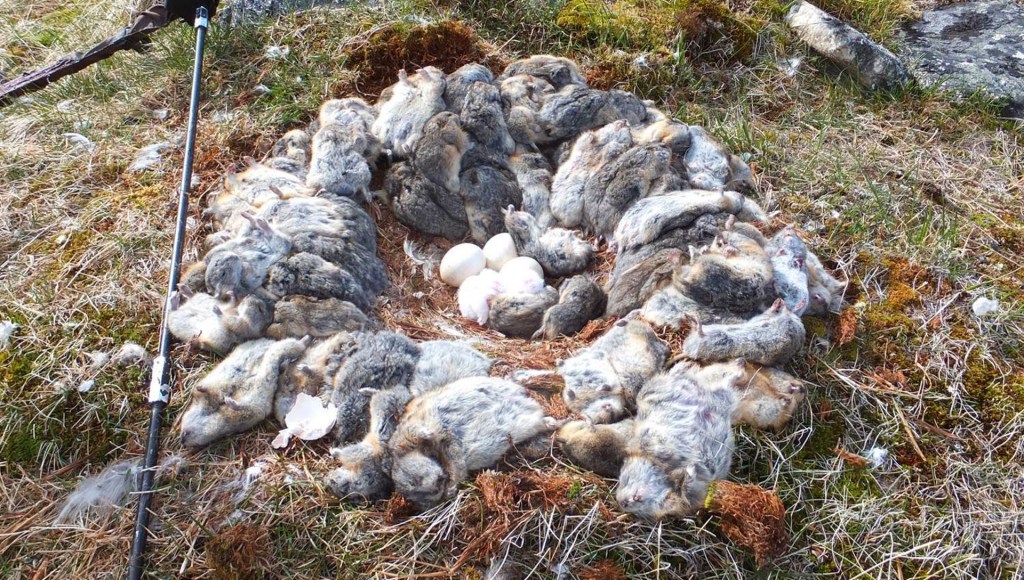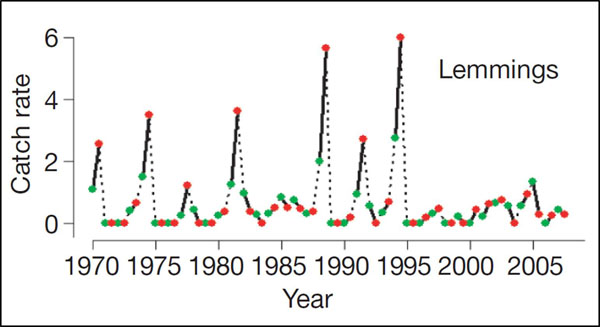A stunning photo is making the rounds on the web of a snowy owl nest wreathed by 70+ lemmings.
The picture tells the story of rich times for one snowy owl; it had so much prey at its disposal that it couldn’t stop itself killing more rodents than it could eat.
This picture presents a hypothesis for this winter’s snowy owl invasion.
Here’s the idea: a superabundance of lemmings occurring in summer 2013 during the owls’ nesting season resulted in high nesting success. No baby owls went hungry and a superabundance of owls fledged.
Seeking to space themselves out, many of these young, well-fed owls are now invading unusually southern latitudes throughout North America.
At this point, we can’t be sure what has brought all of these owls south, but we do know that lemmings play a critical role in influencing snowy owl breeding distribution and nesting success. Beyond their role in the lives of owls, lemmings influence almost all aspects of arctic ecosystems.
![Lemmings influence almost all aspects of arctic ecosystems. Photo © User:CambridgeBayWeather or [1] (Own work) GFDL, CC-BY-SA-3.0, via Wikimedia Commons](https://blog.nature.org/wp-content/uploads/2014/01/North_American_Brown_Lemming.jpg)
Scientists keep coming back to study these rodents because the causes of lemming population cycles are still not entirely understood. There are two competing hypotheses.
The first is that predators drive lemming cycles. Fox, skua, and snowy owl populations increase as lemming prey increases. At some point in time, the lemmings get overrun by predators and the lemming population crashes.
Shortly thereafter, populations of empty-bellied predators crash due to the dearth of lemmings.
The second hypothesis is that the lemmings cause their own misfortune. When populations of lemmings increase to high levels, they deplete their own food resources. They overgraze the moss and grasses that form their main diet, which then leads to a population crash.
Beyond their role in the lives of owls, lemmings influence almost all aspects of arctic ecosystems.
Joe Smith
Scientists can’t agree on which of these hypotheses is correct – or for that matter, whether both factors may play a role. Although the ultimate explanation for lemming cycles is elusive, their impact on arctic wildlife is profound.
Lemming cycles influence species that aren’t even lemming predators. For example, it’s been well established that shorebirds suffer higher rates of egg predation and nest failure in low lemming years as foxes and other predators shift from lemming hunting to nest finding.[1]
Geese respond to low lemming conditions by moving their nests adjacent to snowy owl nests. Talon-brandishing owls keep the area clear of nest-robbing foxes. The geese benefit from the snowy owl’s defense of its own nest.[2]
Just as these fascinating ecological relationships are being revealed, climate change appears to be influencing population cycles of arctic wildlife.
In Norway, lemming population cycles have flattened out since the mid-1990s.
The corresponding cycles of bird reproductive success have also flattened out. And populations of arctic foxes and snowy owls in Norway have declined dramatically. Predator declines are likely due to the lack of dramatic peaks of lemming abundance.[3]
There’s strong evidence that the condition of snow cover is causing the flattening of lemming cycles in Norway. Lemmings conduct a lot of business under the snow – from feeding on mosses to reproducing.
Warmer and more humid weather has created wetter, less crusty under-snow habitat conditions for lemmings that prevent them from flourishing.
On the other hand in the Canadian high Arctic, the domain of our North American snowy owls, lemming cycles remain intact and robust. Researchers predict a trend of increasing snow depth in this region as a result of climate change that will benefit lemming populations.[4]
Time will tell if climate change is playing a role in the recent snowy owl boom in North America.
The Arctic is a big place, and it is clear that conditions for lemmings in some parts of the Arctic remain prime or are getting better, making good times for snowy owls and bird watchers alike.





25 or 30 years ago it was a very common site in very early evening hours to see a white colored owl flying over the farm fields in our area in central Ohio what type of owls would that of been would we have had snow Owls I want to say it was fall or possibly early winter because the crops were off?
L E M M I N G.
This is probably a minor point but you have the wrong species of lemming pictured in the discussion of the invasions of North American birds of prey. The lemming pictured is the Norway Lemming (Lemmus lemmus). It should be the brown lemming (Lemmus trimucronatus) which lives in the high arctic of No. America. I spent the summer of 1960 trapping these lemmings as part of Frank Pitelka’s team working on lemming population dynamics at Point Barrow, and the north slope of Alaska and know them well. It is interesting to learn that the Norway lemming has stopped cycling possibly due to warming. Pitelka had an idea that the cold arctic conditions delayed the cycling of nutrients from lemming carcasses to plants and this drove the cycle. As the arctic warms one could expect the cycles to dampen out.
Thank you for the correction and the additional information on these lemmings!
Actually, getting the right variety of lemming in the photos is rather important, as I grew confused when trying to match the article to the photos. I finally decided that the reference to “Arctic” was meant to include all lemming and snowy owl populations across the hemisphere.
Norway lemmings being cuter, I can certainly understand Smith’s temptation to favor their photos over those of brown lemmings; but for the sake of us non-scientist readers, accurate information helps.
cute lemmings
What is the date (year?) of that photo?
Joe – great blog piece. I did some digging to find out if there was an actual lemming explosion or it was something else, and found this tiny blog piece – that hypothesized that 2012 would be good for Snowy Owl – maybe it got delayed a year?!
http://arcticwatch.ca/blog/summer-2012-looks-good-for-snowy-owls
Other blogs have spoken about it, but I failed to find a biological report on the lemming numbers for 2013.